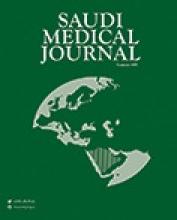Abstract
OBJECTIVE: To describe and assess gender differences in current cigarette smokers' according to certain variables including prevalence, access to tobacco, knowledge and attitude, environmental tobacco smoke, cessation of smoking, tobacco related advertisements, and education on tobacco in school among adolescents in grades 7-12 in Tabuk, Saudi Arabia.
METHODS: A random sample of schools in Tabuk city was obtained using a 2-stage cluster, in April 2005. A total of 16 governmental schools were selected. Within the schools, 48 classes were selected, targeting grades was 7 to 12. An anonymous, self-administered questionnaire was used to select 1,505 participants, with 96% response rate.
RESULTS: Out of 1,505 students, 22.3% (34% males, 11.1% females) were current cigarette smokers (students who had smoked on one or more days in the 30 days preceding the survey), and 5.8% (11.1% males, 0.7% females) were daily smokers. There were significant gender differences concerning source of cigarettes, usual place of smoke, intensity of smoking, knowledge on addiction of tobacco, exposure to education on tobacco, attitudes, and exposure to tobacco smoke in public places. While no significant gender differences were found with respect to age of initiation, knowledge of health hazards of tobacco, exposure to media, desire to quit, or exposure to tobacco smoke at home.
CONCLUSION: For the suppression of the use of tobacco by adolescents in Saudi Arabia differential intervention strategies and policies in males and females are needed, such as reducing youth access to cigarettes-in addition to intensive school and community anti-tobacco programs.
- Copyright: © Saudi Medical Journal
This is an open-access article distributed under the terms of the Creative Commons Attribution-Noncommercial-Share Alike 3.0 Unported, which permits unrestricted use, distribution, and reproduction in any medium, provided the original work is properly cited.






